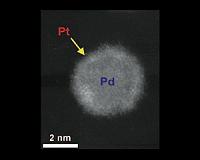 |
Boston MA (SPX) Nov 26, 2010 Making fuel cells practical and affordable will not happen overnight. It may, however, not take much longer. With advances in nanostructured devices, lower operating temperatures, and the use of an abundant fuel source and cheaper materials, a group of researchers led by Shriram Ramanathan at the Harvard School of Engineering and Applied Sciences (SEAS) are increasingly optimistic about the commercial viability of the technology. Ramanathan, an expert and innovator in the development of solid-oxide fuel cells (SOFCs), says they may, in fact, soon become the go-to technology for those on the go. Electrochemical fuel cells have long been viewed as a potential eco-friendly alternative to fossil fuels-especially as most SOFCs leave behind little more than water as waste. The obstacles to using SOFCs to charge laptops and phones or drive the next generation of cars and trucks have remained reliability, temperature, and cost. Fuel cells operate by converting chemical energy (from hydrogen or a hydrocarbon fuel such as methane) into an electric current. Oxygen ions travel from the cathode through the electrolyte toward the anode, where they oxidize the fuel to produce a current of electrons back toward the cathode. That may seem simple enough in principle, but until now, SOFCs have been more suited for the laboratory rather than the office or garage. In two studies appearing in the Journal of Power Sources this month, Ramanathan's team reported several critical advances in SOFC technology that may quicken their pace to market. In the first paper, Ramanathan's group demonstrated stable and functional all-ceramic thin-film SOFCs that do not contain any platinum. In thin-film SOFCs, the electrolyte is reduced to a hundredth or even a thousandth of its usual scale, using densely packed layers of special ceramic films, each just nanometers in thickness. These micro-SOFCs usually incorporate platinum electrodes, but they can be expensive and unreliable. "If you use porous metal electrodes," explains Ramanathan, "they tend to be inherently unstable over long periods of time. They start to agglomerate and create open circuits in the fuel cells." Ramanathan's platinum-free micro-SOFC eliminates this problem, resulting in a win-win: lower cost and higher reliability. In a second paper published this month, the team demonstrated a methane-fueled micro-SOFC operating at less than 500 degrees Celsius, a feat that is relatively rare in the field. Traditional SOFCs have been operating at about 800? degrees C, but such high temperatures are only practical for stationary power generation. In short, using them to power up a smartphone mid-commute is not feasible. In recent years, materials scientists have been working to reduce the required operating temperature to about 300? degrees C, a range Ramanathan calls the "sweet spot." Moreover, when fuel cells operate at lower temperatures, material reliability is less critical-allowing, for example, the use of less expensive ceramics and metallic interconnects-and the start-up time can be shorter. "Low temperature is a holy grail in this field," says Ramanathan. "If you can realize high-performance solid-oxide fuel cells that operate in the 300? degrees C range, you can use them in transportation vehicles and portable electronics, and with different types of fuels." The use of methane, an abundant and cheap natural gas, in the team's SOFC was also of note. Until recently, hydrogen has been the primary fuel for SOFCs. Pure hydrogen, however, requires a greater amount of processing. "It's expensive to make pure hydrogen," says Ramanathan, "and that severely limits the range of applications." As methane begins to take over as the fuel of choice, the advances in temperature, reliability, and affordability should continue to reinforce each other. "Future research at SEAS will explore new types of catalysts for methane SOFCs, with the goal of identifying affordable, earth-abundant materials that can help lower the operating temperature even further," adds Ramanathan. Fuel cell research at SEAS is funded by the same NSF grant that enabled the "Robobees" project led by Robert J. Wood, Assistant Professor of Electrical Engineering. Wood and Ramanathan hope that micro-SOFCs will provide the tiny power source necessary to get the flying robots off the ground. Ramanathan's co-authors on the papers were Bo Kuai Lai, a Research Associate at SEAS, and Ph.D. candidate Kian Kerman '14.
Share This Article With Planet Earth
Related Links Harvard University Powering The World in the 21st Century at Energy-Daily.com
 New Highly Stable Fuel-Cell Catalyst Gets Strength from its Nano Core
New Highly Stable Fuel-Cell Catalyst Gets Strength from its Nano CoreUpton NY (SPX) Nov 11, 2010 Stop-and-go driving can wear on your nerves, but it really does a number on the precious platinum that drives reactions in automotive fuel cells. Before large fleets of fuel-cell-powered vehicles can hit the road, scientists will have to find a way to protect the platinum, the most expensive component of fuel-cell technology, and to reduce the amount needed to make catalytically active electrode ... read more |
|
| The content herein, unless otherwise known to be public domain, are Copyright 1995-2010 - SpaceDaily. AFP and UPI Wire Stories are copyright Agence France-Presse and United Press International. ESA Portal Reports are copyright European Space Agency. All NASA sourced material is public domain. Additional copyrights may apply in whole or part to other bona fide parties. Advertising does not imply endorsement,agreement or approval of any opinions, statements or information provided by SpaceDaily on any Web page published or hosted by SpaceDaily. Privacy Statement |